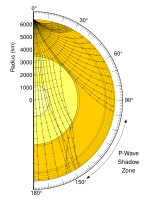P Waves
(https://en.wikipedia.org/wiki/P-wave)P-waves are a type of body wave, called seismic waves in seismology, that travel through a continuum and are the first waves from an earthquake to arrive at a seismograph. The continuum is made up of gases (as sound waves), liquids, or solids, including the Earth. P-waves can be produced by earthquakes and recorded by seismographs. The name P-wave can stand for either pressure wave as it is formed from alternating compressions and rarefactions or primary wave, as it has the highest velocity and is therefore the first wave to be recorded.[1]In isotropic and homogeneous solids, the mode of propagation of a P-wave is always longitudinal; thus, the particles in the solid vibrate along the axis of propagation (the direction of motion) of the wave energy.
P waves help determine the make of the inner core because they travel faster when traveling through denser material. This can be calculated by the the following equation known as Birch's Law.
(https://en.wikipedia.org/wiki/P-wave)Geologist Francis Birch discovered a relationship between the velocity of P waves and the density of the material the waves are traveling in:
(http://www.astro.uwo.ca/~jlandstr/planets/webfigs/earth/images/waves.gif)
S Waves
(https://en.wikipedia.org/wiki/S-wave)S-waves, secondary waves, or shear waves (sometimes called an elastic S-wave) are a type of elastic wave, and are one of the two main types of elastic body waves, so named because they move through the body of an object, unlike surface waves.The S-wave moves as a shear or transverse wave, so motion is perpendicular to the direction of wave propagation. The wave moves through elastic media, and the main restoring force comes from shear effects. These waves do not diverge, and they obey the continuity equation for incompressible media:
There is a blind spot where P waves can't penetrate to which is the Earth's core. S waves also can't reach the core because they can't get past the molten outer core, but P waves can reach the boundary of the solid inner core, turn into S waves, and come back out again as P waves. Based on the speed/time it took for these waves to reach the other end, Scientists are able to determine the type of material that makes up the Earth's core.



No comments:
Post a Comment